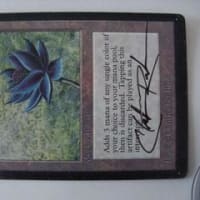The dust had hardly settled on the Gencon Vintage Championships when my team began brainstorming what we might play at the next StarCityGames.com Power 9 tournament.
Take a look at the Top 8 decks from GenCon. Each of these decklists have one commonality that you also find in the decks of other formats. Creatures. And for the most part I'm not talking about creatures used just as combo parts like Academy Rector or Worldgorger Dragon. I'm talking about bona fide creatures that use a mysterious and enigmatic part of the turn called the "attack step." Certainly, Simister's Belcher deck doesn't attack with Elvish Spirit Guide, but his sideboard Xantid Swarms certainly do. Simister's Belcher deck had more creatures that join the board than my mono-Blue deck.
Having dusted off mono-Blue to chomp through a vulnerable metagame, I began thinking about Oath before the tournament had even ended. My second round opponent was playing an unpowered Oath variant that scared the bejeezus out of me due to the latent memory of Kevin Cron smashing my mono-Blue with his Sapphire Oath two years prior.
With a field like Mono-Blue, Fish, Workshop Aggro, and heavy Goblin Welders, Sapphire Oath seemed like something that would be the next metagame answer. Almost immediately, we began brainstorming lists and tuning. We had made some progress towards a solid Oath list when the spoiler for Kamigawa stopped us in our tracks. Suddenly, we were presented with an entirely new option of using Forbidden Orchard to win the short game instead of aiming to win the long-long game. At first we were frustrated because we felt that our efforts might be undermined as Oath would accrue new attention.
Again, we had made some progress and began narrowing our choices for the power nine tournament down to a few decks when we were handed a superior Oath list. We had been using combination of creature kills that included the obvious Darksteel Colossus, Trike, Weaver, and even Cognivore when Kevin Lowry, a friend of Meandecker Doug Linn, dominated my Columbus Mox Tournament in late September with a list that had Platinum Angel, Spirit of the Night, and Akroma.
Kevin's list appeared janky at sight. But I began playing with it just to see what it had going for it. I noticed hidden synergies and set a course to tune it. Several test sessions later and we had quickly arrived at a fully tuned list. The final decisions had to be made based upon optimizing for various matchups.
Take a look at the Top 8 decks from GenCon. Each of these decklists have one commonality that you also find in the decks of other formats. Creatures. And for the most part I'm not talking about creatures used just as combo parts like Academy Rector or Worldgorger Dragon. I'm talking about bona fide creatures that use a mysterious and enigmatic part of the turn called the "attack step." Certainly, Simister's Belcher deck doesn't attack with Elvish Spirit Guide, but his sideboard Xantid Swarms certainly do. Simister's Belcher deck had more creatures that join the board than my mono-Blue deck.
Having dusted off mono-Blue to chomp through a vulnerable metagame, I began thinking about Oath before the tournament had even ended. My second round opponent was playing an unpowered Oath variant that scared the bejeezus out of me due to the latent memory of Kevin Cron smashing my mono-Blue with his Sapphire Oath two years prior.
With a field like Mono-Blue, Fish, Workshop Aggro, and heavy Goblin Welders, Sapphire Oath seemed like something that would be the next metagame answer. Almost immediately, we began brainstorming lists and tuning. We had made some progress towards a solid Oath list when the spoiler for Kamigawa stopped us in our tracks. Suddenly, we were presented with an entirely new option of using Forbidden Orchard to win the short game instead of aiming to win the long-long game. At first we were frustrated because we felt that our efforts might be undermined as Oath would accrue new attention.
Again, we had made some progress and began narrowing our choices for the power nine tournament down to a few decks when we were handed a superior Oath list. We had been using combination of creature kills that included the obvious Darksteel Colossus, Trike, Weaver, and even Cognivore when Kevin Lowry, a friend of Meandecker Doug Linn, dominated my Columbus Mox Tournament in late September with a list that had Platinum Angel, Spirit of the Night, and Akroma.
Kevin's list appeared janky at sight. But I began playing with it just to see what it had going for it. I noticed hidden synergies and set a course to tune it. Several test sessions later and we had quickly arrived at a fully tuned list. The final decisions had to be made based upon optimizing for various matchups.











